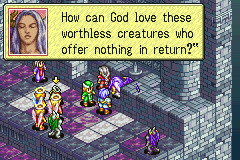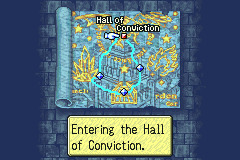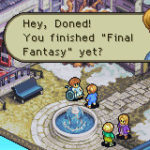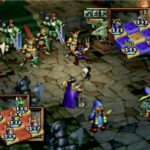Every game in the Ogre Battle/Tactics Ogre series tells essentially a political story. There usually is a “big bad” — as there is in this game — but just as usually, the big bad isn’t the real villain.
So some background: Tactics Ogre: The Knight of Lodis is the last new entry in the Ogre Battle series, published for the Gameboy Advance in 2001 (Japan) and 2002 (rest of the world). Some games in the series have been ported to more modern consoles, some have been remade, but this was the last chapter of the story (though it takes place between the first two games, the SFC/SNES “Ogre Battle: The March of the Black Queen” and the SNES/PS1/etc “Tactics Ogre: Let Us Cling Together”). The Knight of Lodis, like Let Us Cling Together and their spiritual successor Final Fantasy Tactics, is a turn-based tactics RPG. The other games in the series are real time tactics games.
I played this game on an Analogue Pocket, a handheld console that emulates the Gameboy, Gameboy Color and Gameboy Advance in hardware, and is compatible with the cartridges for those systems. Adapters allow use of Neo Geo Pocket Color, Game Gear and Atari Lynx cartridges directly. Its re-programmable FPGA cores allow emulation of dozens of other handhelds, consoles, and computers. It’s pretty neat.
I have the optional dock that allows for charging and HDMI output, and I used that to capture the video below. The screenshots are so small because… that’s the resolution of the actual game. It’s not from an emulator.
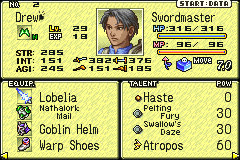
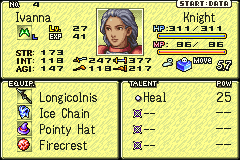
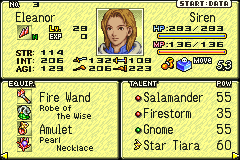

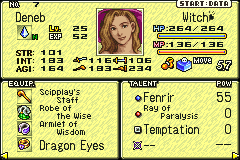
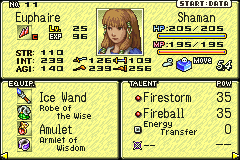
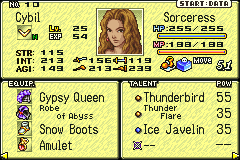
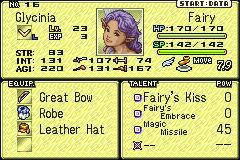
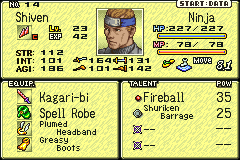
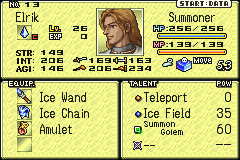

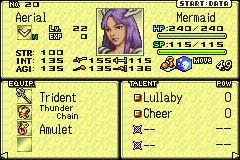
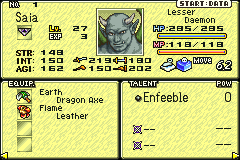
As with Ostorea Castle, when approaching the Netherworld, we have to split our forces into two to defeat the defenses before being able to face the boss. Fortunately, I’ve made a pretty strong army to this point. Eleanor, the protagonist’s romantic partner, asks to stay with the protagonist and be part of the battles, and this is very important to the plot. Eleanor’s story is key to many of the endings.
Eleanor has the ability “Star Tiara”, which does nasty things to the undead on the map, and fair damage to everything else. She forgets it after she uses it, but then remembers it when the battle is done.
The protagonist, Alphonse, is wielding Lobelia. This is actually the Angel Knight Lobelia, who has been transformed into a powerful sword with a Snapdragon scroll. Without doing this, the demon Saia would refuse to join the team.
Ivanna, the local general that Alphonse initially allies with, wields the sacred spear Longcolnis.
Canopus is a named character from other games in the series. He’s not actually in this game; I just recruited a Hawkman and named him Canopus. He actually is the enemy of Alphonse in the next game…
Deneb is a character in most of the games in the series. She isn’t playable in Tactics Ogre 64: Person of Lordly Caliber, where she handles unit training, but she is in all the other games, though you may have to hop through some hoops to find and recruit her — as is true here, too.
Euphaire is an enemy you can recruit. She’s… not herself when you first meet. If you can stop her dad Elrik from killing her, he’ll join as well.
Cybil and Shiven are Church assassins who change the course of Alphonse’s entire life. Never fully trustworthy, Alphonse (in some endings) takes her place as the strong, dark arm of the Church.
Glycinia begs you to find her sister, Lubinia, and both join your team. The mermaids are the legendary possessors of the Sacred Spear that can kill anything — even an angel — and Aerial will join your team if you can earn her trust.
And Saia is a demon who will join you if you don’t have his enemy, the angel knight Lobelia, in your team. He just wants to hit things really hard.
So from this army, it wasn’t hard to make two powerful teams.
My usual team was Alphonse, Euphaire, Elrik, Eleanor, Ivanna, a priestess, and two others that I would choose based on the particular fight.
Once Alphonse learned the powerful sword attack Atropos, which hits for four times damage at the expense of Alphonse’s health, my usual strategy was to have Euphaire feed power to Elrik, who would teleport Alphonse directly to the boss, and then Alphonse would attempt to assassinate the boss with Atropos. If it didn’t kill it, it would be wounded. Elrik would then teleport Ivanna over to heal Alphonse, and the other priest would stay behind to heal Euphaire as she fed power to Elrik to place the other units where they needed to be. I was able to skip a lot of trash kills with this method.
So how does this game stand against the others in the series? Well, the politics is complicated. There’s a lot of stuff happening behind the scenes, main character Alphonse isn’t aware of most of them. The location, the island Ovis, is split into north and south by impassable mountains, so you have the northern and southern factions against each other. Lodis has the Order of the Sacred Flame, the main army, and the Church struggling for control. The countries of Galius and Feris are causing issues. The game does introduce these elements, but it really helps to write down just who all the characters, PCs and NPCs alike, are allied with in order to follow what is actually happening.
Alphonse himself is easily swayed to one faction or another based largely on whomever he talked to more recently. His options narrow as he goes through the game until he can finally not escape whatever destiny he has been forging. In my playthrough, he becomes the antagonist of the next game (although, since Ogre Battle is so complicated, it’s unclear if he is really a bad guy). Other decisions can lead to very different outcomes.
Compared to Final Fantasy Tactics
I, and probably a lot of tactical RPG fans, come to the Ogre Battle series through Final Fantasy Tactics, the spiritual successor to the Ogre Battle turn-based games, done by the same team who did the first couple games.
So how does it compare?
No ATB (Active Time Battle). In FFT, characters attack based on their speed, and as such, speed is vitally important. In TKoL, each side moves all their pieces at once.
No rotating the battlefield. In FFT, battlefield structures have hidden areas you can see by rotating the map. In TKoL, no such thing — everything is always visible, and if you can’t see it, you don’t have to worry about it.
Fewer classes/jobs. TKoL has twelve jobs, some of which are gender-locked. FFT has way more, and they are more distinct.
Spells are inventory items. This is kind of neat. Spells can be bought, found, crafted or dropped from enemies. IIRC, in FFT, all jobs have all their skills available.
Classes are achievement-locked. This is also kind of cool. TKoL has an achievement system (called “emblems”) that you earn by doing various things. These can unlock special, powerful, classes. In FFT, jobs are unlocked by unlocking other jobs and meeting other requirements.
No autobattling for storyline missions. You can autobattle in training missions, though these don’t give loot or gold. (er, goth). In main missions or random encounters, it’s all you.
No multiclassing. FFT has the job system that lets you spend job points to unlock abilities to use in other jobs. Since many abilities and spells in TKoL are inventory items, you can design your own character abilities to a certain extent.
Characters have a bunch of hidden and unhidden stats to worry about. Every character has a biorhythm that affects their performance. You can get hints as to how this is doing, and emblems can affect them. Every character has an element (fire vs water, air vs earth, dark vs divine) that is strong against its opposite. A lot of gear is also elemental, so building a powerful character means matching its element with its skills and gear and being in group when their biorhythm is high. Now, the effects of these not matching up doesn’t drastically nerf a character, but you’re going to want to train and equip your characters carefully.
Individual battles take a long time to complete — unless you’re strategic. At least if you aren’t being strategic. In FFT, aside from boss battles, I’d let things run automatically and just step in when necessary. In TKoL, a straightforward approach is slow, and you’ll need to bring the right team to the battle depending on your needs (Defense? Mobility? High magic attack? High physical attack?)
Recruiting enemies is important. In FFT, certain jobs can recruit certain enemies, but it isn’t necessary. In TKoL, it is. Every character has a chance at recruiting, but the protagonist and Ivanna have better base chances. This can be raised by being of a compatible class and of the opposite gender. The reason to do it is because enemies have spells, skills, rare gear and common gear that they do not drop when killed. You can also get powerful classes well before you could unlock them yourself. Money is scarce in TKoL; being able to recruit an enemy helps you in that fight, but afterward, you can strip them of their gear and sell the pieces you don’t want. No more money problems.
My end screen stats show just how many enemies I recruited, stripped, and disposed of. There were more that I kept on the team afterwards; the hidden stats and stuff means you’ll want variety in your army.
TKoL is an important game in the series. It’s on the balance a little easier than FFT, the plot is a little more complicated, and as far as I know, has never been re-released on another platform. The team who developed TKoL joined Square when Square bought out Quest, and went on to develop Final Fantasy Tactics Advance, which I have written about here.
